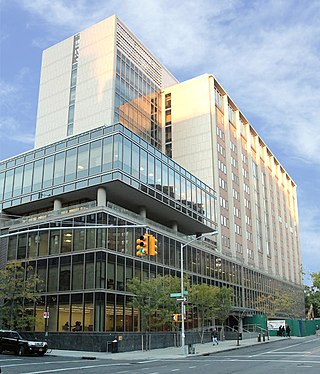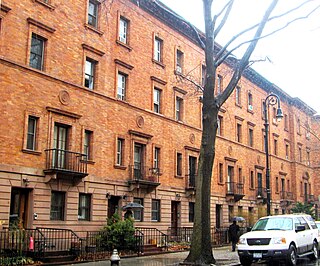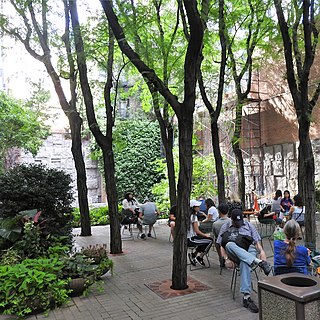
Murray Hill is a neighborhood on the east side of Manhattan in New York City. Murray Hill is generally bordered to the east by the East River or Kips Bay and to the west by Midtown Manhattan, though the exact boundaries are disputed. Murray Hill is situated on a steep glacial hill that peaked between Lexington Avenue and Broadway. It was named after Robert Murray, the head of the Murray family, a mercantile family that settled in the area in the 18th century.

Cobble Hill is a neighborhood in the northwestern portion of the New York City borough of Brooklyn. A small neighborhood comprising 40 blocks, Cobble Hill sits adjacent to Brooklyn Heights to the north, Boerum Hill to the east, Carroll Gardens to the south, and the Columbia Street Waterfront District to the west. It is bounded by Atlantic Avenue (north), Court Street (east), Degraw Street (south) and the Brooklyn Queens Expressway (west). Other sources add to the neighborhood a rectangle bounded by Wyckoff Street on the north, Hoyt Street on the east, Degraw Street on the south, and Court Street on the west.

Lexington Avenue, often colloquially abbreviated as "Lex", is an avenue on the East Side of Manhattan in New York City. The avenue carries southbound one-way traffic from East 131st Street to Gramercy Park at East 21st Street. Along its 5.5-mile (8.9-kilometer), 110-block route, Lexington Avenue runs through Harlem, Carnegie Hill, the Upper East Side, Midtown, and Murray Hill to a point of origin that is centered on Gramercy Park. South of Gramercy Park, the axis continues as Irving Place from 20th Street to East 14th Street.

Hospital for Special Surgery (HSS) is an academic medical center and research institution headquartered in New York City that specializes in the treatment of orthopedic and rheumatologic conditions. Its main campus is located at 535 East 70th Street in Manhattan and there are locations in New York, New Jersey, Connecticut, and Florida. The hospital was founded in 1863 by James Knight. HSS is the oldest orthopedic hospital in the United States and is consistently ranked as the world's top orthopedic hospital. Bryan T Kelly served as the former surgeon-in-chief and currently serves as president and chief executive officer. Douglas E. Padgett serves as the current surgeon-in-chief.

York Avenue, Sutton Place, and Sutton Place South are the names of segments of a north–south thoroughfare in the Yorkville, Lenox Hill, and Sutton Place neighborhoods of the East Side of Manhattan, in New York City. York Avenue runs from 59th to 92nd Streets through eastern Lenox Hill and Yorkville on the Upper East Side. Sutton Place and Sutton Place South run through their namesake neighborhood along the East River and south of the Queensboro Bridge. Sutton Place South runs from 57th to 53rd Streets. Unlike most north–south streets in Manhattan, building address numbers along Sutton Place South increase when headed south. Sutton Place runs from 57th to 59th Streets. The streets are considered among the city's most affluent, and both portions are known for upscale apartments, much like the rest of the Upper East Side.

Grace Church is a historic parish church in Manhattan, New York City which is part of the Episcopal Diocese of New York. The church is located at 800–804 Broadway, at the corner of East 10th Street, where Broadway bends to the south-southeast, bringing it in alignment with the avenues in Manhattan's grid. Grace Church School and the church houses—which are now used by the school—are located to the east at 86–98 Fourth Avenue between East 10th and 12th Streets. In 2021, it reported 1,038 members, average attendance of 212, and $1,034,712 in plate and pledge income.

Sugar Hill is a National Historic District in the Harlem and Hamilton Heights neighborhoods of Manhattan, New York City, bounded by West 155th Street to the north, West 145th Street to the south, Edgecombe Avenue to the east, and Amsterdam Avenue to the west. The equivalent New York City Historic Districts are:

Stuyvesant Square is the name of both a park and its surrounding neighborhood in the New York City borough of Manhattan. The park is located between 15th Street, 17th Street, Rutherford Place, and Nathan D. Perlman Place. Second Avenue divides the park into two halves, east and west, and each half is surrounded by the original cast-iron fence.

Robert Henderson Robertson was an American architect who designed numerous houses, institutional and commercial buildings, and churches.

Starrett & van Vleck was an American architectural firm based in New York City which specialized in the design of department stores, primarily in the early 20th century. It was active from 1908 until at least the late 1950s.

The Francis F. Palmer House is the centerpiece of a complex of residential buildings located at 67, 69, and 75 East 93rd Street in New York City, known collectively as the George F. Baker Jr. Houses. They were completed during the years 1918–1931 to the designs of the architecture firm Delano & Aldrich. In 1982, the entire ensemble was added as a group to the National Register of Historic Places.

Gouverneur Health, formerly Gouverneur Hospital, is a municipally owned healthcare facility in New York City affiliated with the New York University School of Medicine. It is located at 227 Madison Street in Lower Manhattan. The facility offers comprehensive healthcare services, including outpatient, specialty, and skilled nursing care. It primarily serves residents of Manhattan, Brooklyn and Queens.

P.S. 135, also known as P.S. 35, is a historic school building located at 931 First Avenue at East 51st Street in the Turtle Bay neighborhood of Manhattan, New York City. It was built in 1892 on the site of "Mount Pleasant", the estate of James Beekman. The school was designed by George W. Debevoise in the Romanesque revival style., and has been at various times a community center, a homeless shelter and a nursery school, as well as the United Nations International School. There was an addition made to the building in 1904.

George Willard Conable (1866-1933), AIA, was an American architect practicing in New York City in the early to mid 20th century specializing in churches.
Frederick T. van Beuren Jr., M.D. was a physician, surgeon, medical school administrator, professor, researcher, and hospital administrator. He graduated from the Columbia University College of Physicians and Surgeons. He later became the chief of its surgery clinic and an instructor in surgery. Even later, he became its associate dean and associate clinical professor of surgery. He was a vice president of the New York Academy of Medicine. While researching gastroenterological surgery, he conducted long-term studies at Roosevelt Hospital and Presbyterian Hospital. He also was president of Morristown Memorial Hospital in New Jersey.

The St. Nicholas Historic District, known colloquially as "Striver's Row", is a historic district located on both sides of West 138th and West 139th Streets between Adam Clayton Powell Jr. Boulevard and Frederick Douglass Boulevard, in the Harlem neighborhood of Upper Manhattan, New York City. It is both a national and a New York City historic district, and consists of row houses and associated buildings designed by three architectural firms and built in 1891–93 by developer David H. King Jr. These are collectively recognized as gems of New York City architecture, and "an outstanding example of late 19th-century urban design":

The Hebrew Tabernacle of Washington Heights is an historic Reform Jewish synagogue located at 551 Fort Washington Avenue, on the corner of 185th Street, in the Washington Heights neighborhood of Manhattan in New York City, New York, U.S. The domed Art Deco style building was built as a church for the Fourth Church of Christ, Scientist, in 1932 and converted to a synagogue in 1973.

Greenacre Park is a privately owned, publicly accessible vest-pocket park located on East 51st Street between Second and Third Avenues in the Turtle Bay neighborhood of Manhattan, New York City.






















